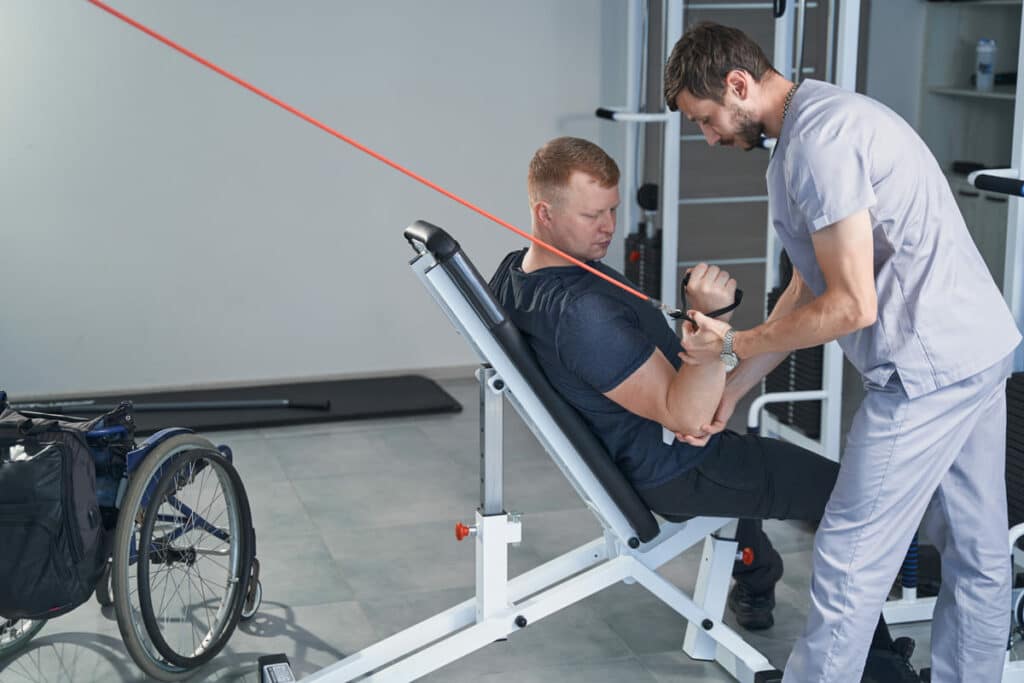It is understandable to have a sense of trepidation when considering a new experience such as physical therapy. However, learning more about it and how it works will help lessen anxiety and give you a greater understanding of the many benefits that it has to offer.
Physical therapy can be invaluable for people of all ages, especially when extended illness, accidents, or other injuries lead to painful movements or restricted mobility. It can lead to drastic improvements in quality of life and help restore muscles, improve bone strength, strengthen the heart and lungs, and even improve brain function!
However, most people are anxious about physical therapy because they fear that it will be a painful experience. There may, in fact, be discomfort and soreness, but generally, this is the good kind of pain, like what comes with exercise and strength building — the kind that is your body telling you that it is growing stronger!
The major goal of physical therapy is to reduce pain, so initial discomfort will pay wonderful dividends down the line.
What is Physical Therapy?
Physical therapy is a treatment regime designed to help alleviate pain related to performing daily activities in life. This may be the result of a sports injury, illness, surgery, or even complications arising from advanced age.
If you are suffering muscle weakness, suffer from limited mobility, or experience pain or soreness when walking or performing physical activities, you can likely benefit from the services of a physical therapist (PT).
Highly trained professionals in the healthcare field, physical therapists specialize in helping resolve these issues so that you can enjoy a return to form or at least a greater quality of life.
While patients are often referred to a physical therapist through their physicians, you can also choose to consult one on your own. However, if you are experiencing serious symptoms, there may be underlying issues, so in those cases, it may be best to consult a doctor first.

How Does Physical Therapy Work?
Most therapists follow a pretty standard set of protocols when assessing a patient for treatment. They will likely want to take a look at the problem area itself, so make sure to dress accordingly to provide easy access, i.e. it can be difficult to examine your knee when you are wearing blue jeans.
Preliminary Questions
As with most forms of treatment, the first step will be to analyze your current situation and evaluate the extent of your health-related problems. The therapist will likely begin with a few standard questions regarding your medical history, the type of pain you are experiencing, and the location of that discomfort.
It is very important to be completely honest and forthcoming with your therapist because sometimes unknown factors, such as medical conditions or former surgical procedures, can cause adverse effects with some forms of treatment.
Movement Analysis
Next, the PT will want to learn as much about your difficulties as possible, so they will have you perform a series of basic mobility tasks. These are akin to motions you would perform in daily life, with a special focus on analyzing the use of your target area, such as a sore knee.
They will assess a variety of different concerns, such as flexibility, range of motion, strength, balance, coordination, and posture. Collecting this information will help them devise a suitable plan to help you, as well as identify any additional factors that may explain the pain or reduced mobility.
Diagnosis and Establishing Goals
Once the therapist has collected all the relevant data, they will make an official diagnosis of your condition and work in conjunction with you and your primary care physician to establish end goals, as well as a plan to meet them.
These most often include points such as eliminating or reducing pain, building muscle strength, restoring mobility to previous levels, or increasing mobility to improve the ability to perform tasks.
Once a plan is in place, it is time to start physical therapy.

Treatment
Depending on the type of treatment necessary, there are a variety of treatment options designed to build strength, reduce discomfort, reduce swelling, improve circulation and blood flow, and improve flexibility.
Your therapist (potentially in conjunction with an assistant) may:
- Assign an exercise regime with a focus on the target area and monitor you while you perform them
- Facilitate strength and balance training
- Employ heat, ice, or hydrotherapy treatment
- Engage ultrasound or electrical stimulation
- Use dry needling or acupuncture to stimulate muscular trigger points
- Perform massage therapy
Homework
As the major emphasis for nearly every type of physical therapy is exercise, you can expect to do a significant amount to improve your body. While the PT will monitor you as you perform exercises for the first time, and periodically throughout the week, they will also assign you to exercise homework.
This is a necessary evil because, while exercising with a therapist or assistant therapist is helpful, it is not enough to engage in such limited physical activity. There is only a designated amount of time available and the therapist will want to work with you on a variety of different techniques.
That means you will have a structured set of exercises to perform when you are at home. It is crucial to follow this plan to ensure optimum results in your therapy. If you experience any unusual symptoms while performing unsupervised, it is a good idea to pause the activity and contact your therapist for advice.
The Bottom Line
Physical therapy can work wonders in restoring the body to its previous condition, improving mobility and pain after an accident, and strengthening the body to make it easier to do the things in life that you love.
Physical therapists are licensed professionals, experts in their field, and this type of treatment is safe and effective, allowing you to live your best life.
However, the treatment plan is only as effective as your willingness to fully participate, even if that means, and it likely will, engaging in a prescribed exercise routine on your own while at home.











